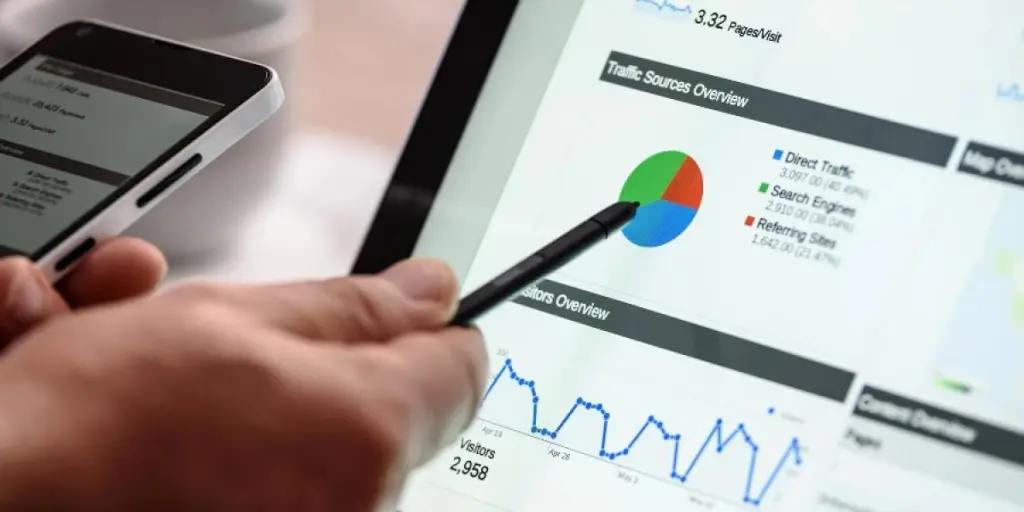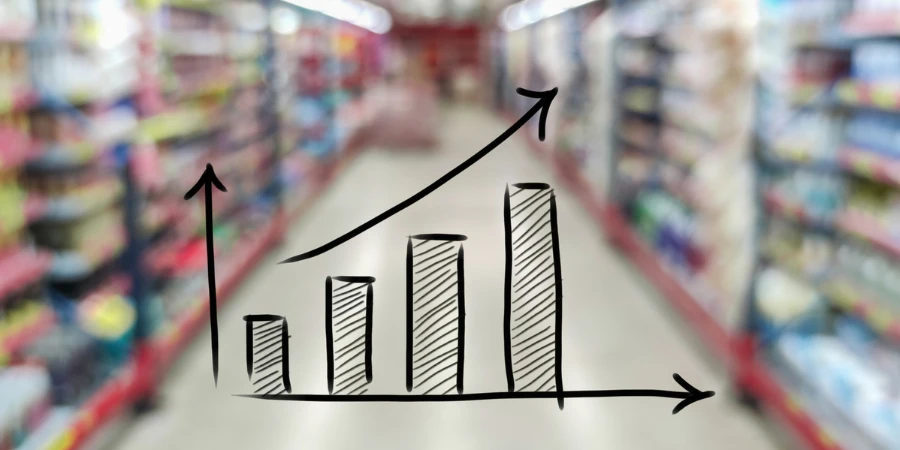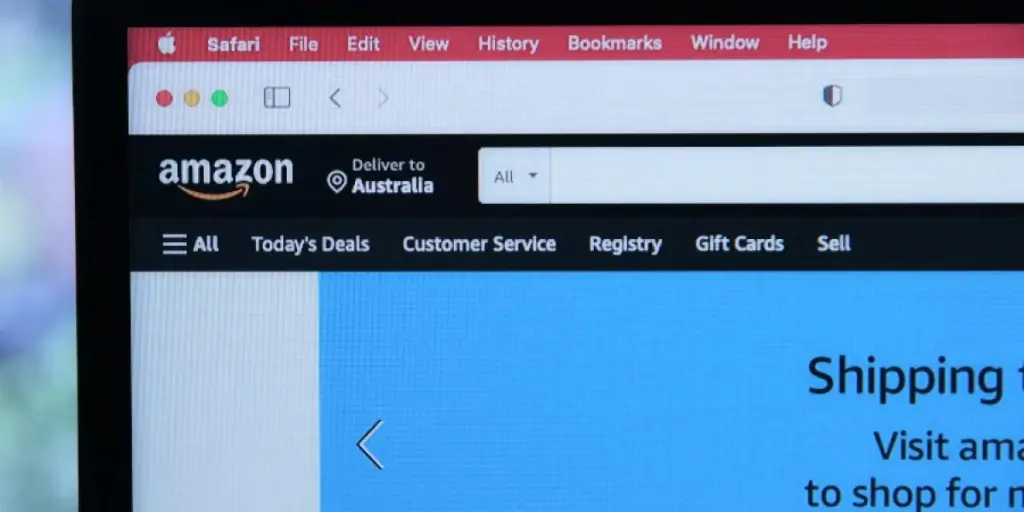It is a common myth that simply tracking ecommerce metrics is enough to achieve ecommerce success.
In reality, it is crucial to have a deeper understanding of the insights gained from these metrics. Understanding ecommerce metrics allows you to evaluate the performance of your online business accurately.
By analyzing the data behind specific metrics, you can identify strengths, weaknesses, and areas for improvement. Only then will you be able to make informed business decisions that drive growth
To help you navigate the complex realm of ecommerce metrics and KPIs, we have compiled a list of 10 key metrics that you must measure.
We’ll also delve into the reality of each metric, helping you understand their importance and use them as a foundation for strategic action plans.
So, let’s dive in.
Table of Contents
What are ecommerce metrics & KPIs?
How to decide which metrics or KPIs to use?
How often should you plan and check ecommerce metrics?
Top ecommerce metrics to track
Wrapping up
What are ecommerce metrics & KPIs?
Metrics and KPIs play a crucial role in any ecommerce marketing strategy.
Ecommerce metrics define your website’s performance, and by analyzing them, you can understand the scope of improvement for your business.
Some marketers use the terms ecommerce metrics and KPIs interchangeably, but they are not exactly the same.
Let’s look at an example to understand the difference between these two concepts.
The average order value of your store is a metric, but an average order value of $30 is a KPI.
In simple English, metrics track your business progress, and KPIs show how effective you are at achieving your goals. KPIs are goal-oriented, and they use metrics to measure how close or far away you are from reaching those goals.
This means: All KPIs are metrics, but not all metrics are KPIs.
The image below summarizes the differences between metrics and KPIs.
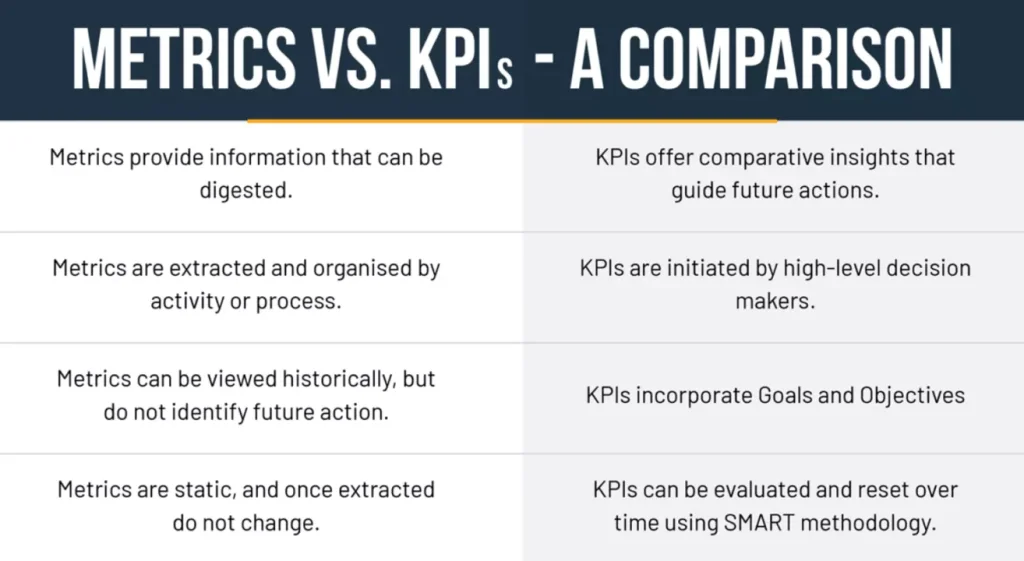
How to decide which metrics or KPIs to use?
Ask these 3 questions to decide
- How significant of a change will the metric have on my business? The more significant the (positive) change, the better.
- Will optimizing the metric have a significant impact on my business’s revenue? In ecommerce, the ultimate goal is to increase revenue, so track website metrics that help you do it.
- Will working on this metric help me improve others as well? Oftentimes, metrics are interconnected, and tweaking one might improve another. For example, when you refine the quality of your traffic, your conversions might increase.
Leverage the SMART approach to choose ecommerce metrics & KPIs
One other way to deal with the metric selection is by leveraging the SMART approach.
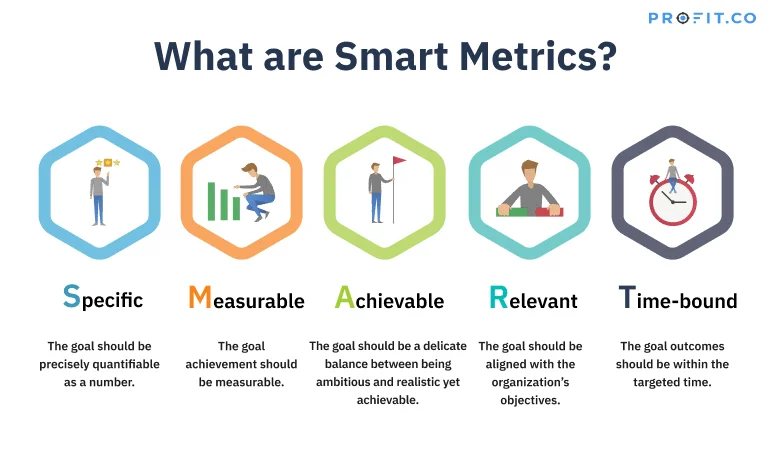
SMART is an abbreviation for:
- Specific: Tracking a highly-specific KPI; if you have traffic coming from multiple sources, track each traffic source individually.
- Measurable: Ensuring that each metric you track is measurable, since ecommerce analytics can’t work on predictions or guesses.
- Actionable: Tracking metrics that allow you to change and improve your ecommerce store by taking specific actions.
- Relevant: Making sure that the data you collect is highly relevant to the metric you’re tracking.
- Time-Sensitive: Making the right adjustments at the right time for optimal impact.
Pro tip: Make a list of all KPIs by asking the three questions mentioned earlier, and then use the SMART approach as a filter to further shortlist the best KPIs and metrics you can measure.
How often should you plan and check ecommerce metrics?
Every ecommerce metric needs a different tracking frequency. Some metrics need to be tracked weekly, while it’s okay for some to be tracked quarterly.
Here are the four timeframes one could track ecommerce metrics:
- Weekly: These are the metrics that ensure your business is running well, such as website traffic, social media engagement, purchases related to limited-time promotional offers, etc.
- Bi-Weekly: If you have a metric with a large sample size, check it twice a month, such as average order value (AOV) or cost per acquisition (CPA).
- Monthly: Metrics that are tracked monthly have some kind of traffic pattern, or they are funnels created by you. This can include your email open rate, shopping cart abandonment, and various automations.
- Quarterly: These metrics are like benchmarks for your business and achieving these KPIs means you’re on the road to success. These metrics can include customer lifetime value and subscription rates.
Top ecommerce metrics to track
Email marketing-related ecommerce metrics
Whatever niche your ecommerce store is in, you will be using email marketing one way or another. This can be for promotions, customer care, or retargeting.
Tracking how your email marketing campaigns perform is the first thing to do.
Let’s see what the key metrics are that you can track when doing email marketing.
Click-to-open rate
The click-to-open rate is the best way to measure your email campaign’s success.
You can do so with this formula:

By measuring the click-to-open rate, you get an idea if your emails have:
- engaging content
- an effective CTA
- ease of interaction
Note: For any email campaign you run, ensure your click-to-open rate is not less than 10%.
Email conversion rate
For any ecommerce business, the ultimate goal is to make a sale. Tracking your email conversion emails is the most important ecommerce metric.
The conversion rate can be calculated as:

You can further multiply the result by 100 to get a percentage value.
Here’s what conversion rate you can expect from your email campaigns.

Unsubscribe rate
When you have a significant number of subscribers, the unsubscribe rate becomes important. Retaining existing customers and keeping them loyal to your brand will increase sales.
Think of why people unsubscribe from your email newsletters. Is it because you send too many emails? Or simply because of poor user experience?
Whatever the reason, try bringing the unsubscribe rate down with every campaign you run.
In ecommerce, you can expect around a 0.3% unsubscribe rate when doing email marketing.
To track all essential email marketing KPIs, you can leverage Omnisend.
Omnisend offers an email automation feature through which you can run campaigns and track important metrics and KPIs simultaneously.

Omnisend provides detailed analytics on the performance of your email campaigns, allowing you to track metrics such as open rates, click-through rates, bounce rates, and conversion rates.
These metrics offer valuable insights into the effectiveness of your campaigns. They enable you to identify areas for improvement and make data-driven decisions to optimize future campaigns.
Ecommerce performance metrics & KPIs you must track
Whatever your traffic source is, tracking metrics that tell you about your store’s performance and optimizing them should be your ultimate goal.
Let’s see what the key metrics and KPIs are that you can’t ignore.
1. Cost Per Acquisition (CPA)
Cost per acquisition is the total cost you spend on acquiring a new customer.
This can be calculated with a simple formula:

Here’s an example of how to calculate CPA:
In November, Jack invested $10,000 in marketing for his online shoe store. He was able to acquire 500 new customers.
Jack’s CPA will be $10000/500 = $20.
This means that Jack spent 20 dollars to acquire one customer in November.
Note: To have a profitable ecommerce store, the average order value should always be greater than the cost per acquisition. In simple terms, you shouldn’t pay more to get a customer than what they spend on your store.
2. Cart abandonment rate
The cart abandonment rate is the percentage of people who have visited your store, added a product to their shopping cart, but for some reason didn’t buy it.
By retargeting these cart abandoners, you can boost conversion rates since this audience has shown specific interest in your product.
According to a report by Dynamic Yield, the average shopping cart abandonment rate is 70.56% as of May 2023. This means that nearly three-quarters of the traffic visiting your store will abandon their cart.
So keeping an eye on the abandonment rate and converting abandoners into buyers is what you want to do. It may sound complicated, but it’s actually pretty straightforward: use a marketing automation platform like Omnisend to automatically send one or a series of cart abandonment emails to catch those shoppers soon after they’ve abandoned their carts.
Here’s the formula to calculate the cart abandonment rate:

3. Average order value (AOV)
AOV is the average amount of money spent each time a customer orders something from your store. This can be for one product or multiple products bought together in one order.
The formula for AOV is quite straightforward:

Tracking AOV as an ecommerce metric helps you set benchmarks and goals for the future.
Some marketers consider AOV to be one of the key ecommerce metrics. Why?
Increasing store traffic or optimizing your store for conversions will cost you, but you can increase AOV without spending a penny by getting shoppers to buy more products in each order.
Here’s how:
- Upsell and cross-sell products wherever possible
- Give customers multiple purchase discounts like ‘buy 3 and get 30% off’
- Offer free shipping
4. Customer retention rate (CRR)
When it comes to ecommerce, the customer retention rate represents the number of customers who buy from you repeatedly over a given period of time.
To calculate CRR, you need to have three values:
- The number of existing customers at the beginning of the time period (S)
- The number of total customers at the end of the time period (E)
- The number of new customers added in the time period (N)
When you have all the three values, just put them in the formula below:

Did You Know: According to AnswerIQ, the average CRR is 31% for the ecommerce industry. So try keeping your store’s CRR below that.
5. Customer lifetime value (CLV)
CLV represents the total amount of money a shopper is expected to spend on your store’s products or services in their lifetime as your customer.
Knowing CLV is crucial as it helps you decide about your investment for CPA and CRR optimization.
CLV is calculated based on three values:
CLV = Average order value X No. of times the customer will buy from you each year X The average length of the customer relationship (in years)
So suppose a baseball player buys a bat worth $200 from your store three times a year.
He does the same for five years. Therefore his CLV would be:
CLV = $200 X 3 X 5 = $3000
6. Ecommerce churn rate
The ecommerce churn rate is a calculation of the percentage of customers a business loses in a given time frame. The formula is:

If you have 200 sales at the start of November and it drops to 180 at the end of the month, the ecommerce churn rate will be:
[(200-180)/200]X100 = 10%
7. Net promoter score (NPS)
The net promoter score is an ecommerce metric that tells you how many customers are willing to recommend your product to others.
Tracking this will give you a clear understanding of where your business is in terms of customer satisfaction and brand loyalty.
To calculate the NPS, you need to understand what promoters and detractors are.
Your promoters are your loyal customers who recommend your products to their friends and family, whereas the detractors are the unhappy customers who won’t be recommending you to anyone.
NPS = %Promoters – %Detractors
8. Sales conversion rates
The sales conversion rate is a key ecommerce metric that measures the percentage of website visitors who make a purchase.
It helps you evaluate the effectiveness of your online sales strategies and the overall performance of your website.
A high sales conversion rate indicates that a higher proportion of visitors are converting into customers. This translates to increased revenue and business success.
On the other hand, a low sales conversion rate suggests that there may be issues that require attention. Some possible issues behind a low sales conversion rate could be:
- Poor website design
- Difficult checkout process
- High-priced products
- Poor customer service
- Ineffective marketing
The formula to calculate the ecommerce sales conversion rate is as follows:
Conversion Rate = (Number of Conversions / Number of Website Visitors) * 100
If your sales conversion rate is low, we recommend looking at your entire ecommerce sales funnel. The typical stages in a sales funnel are Awareness, Interest, Decision, Action, and Retention.
If you have low web traffic, the problem might lie in the awareness stage, indicating the need to improve your marketing efforts to drive more visitors to your website.
If your visitors abandon their carts, the issue may lie in the decision stage. It could be due to unexpected shipping costs, complex checkout processes, or concerns about payment security. Offering free shipping or simplifying the checkout process can help increase conversions.
Ideally, your sales conversion rate should stay steady or increase over time. If that’s not the case, thoroughly investigate to ensure your website works properly.
9. Ecommerce store sessions by traffic source
Tracking and analyzing ecommerce store sessions by traffic source is crucial in seeing where people are landing on your site from. It is also helpful in evaluating the effectiveness of your marketing efforts.
It involves monitoring and categorizing the incoming traffic based on the channels users reach your store.
These may include:
- Organic search: Visitors who landed on your website after clicking on your website in search results.
- Paid advertising: Visitors came across your website through paid ads.
- Social media: A social media platform directs these visitors to your website.
- Email marketing: These visitors may have received an email newsletter that led them to your website.
- Direct traffic: Visitors who directly type in your website into their URL bar.
By identifying the traffic sources, you can determine which marketing channels generate the most visitors. You can allocate your marketing budget and resources more efficiently to channels bringing in the most visitors.
Wrapping up
Ecommerce metrics and KPIs are not just numbers on a spreadsheet. They provide valuable insights into the performance of your ecommerce business, and serve as a compass guiding your strategic decisions.
Start by identifying the key goals and objectives for your ecommerce business. Clear goals will help you determine which metrics to focus on and how to measure them effectively.
Choose metrics that provide meaningful insights into your business performance.
Lastly, invest in robust email marketing tools that help you gather data and track your metrics. Omnisend is a powerful tool designed to help ecommerce businesses thrive. With its comprehensive features and user-friendly interface, Omnisend can provide valuable insights and assist in implementing effective marketing strategies.
So, go ahead and pick the most suitable ecommerce metrics and supercharge your marketing strategies.
Source from Omnisend
Disclaimer: The information set forth above is provided by Omnisend independently of Alibaba.com. Alibaba.com makes no representation and warranties as to the quality and reliability of the seller and products.
